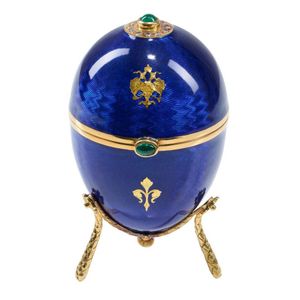18ct Gold Faberge Easter Egg with Diamond & Emerald
A fine 18ct gold, enamel, diamond and emerald limited edition Easter Egg and Surprise, Victor Mayer for Faberge, numbered 1/25 circa 1996. Of ovoid form applied with Royal Blue guilloche enamel supported on a gold base with three finely chased legs, the lid decorated with a cabochon emerald and diamond cluster finial and gold Russian Imperial eagle and fleur-de-lys, with emerald push piece, the emeralds together weighing approximately 1.32 carats opening to reveal a brilliant-cut diamond weighing 1.12 carats within a circular gold collet, weight approximately 129 grams, height approximately 750 mm, signed Faberge, with workmaster's marks for Victor Mayer, numbered 1/25, accompanied by a Faberge certificate, presentation box and outer packaging. Accompanied by an international Gemmological Institute laboratory report numbered F2D14084 stating colour F, clarity VVS2.
You must be a subscriber, and be logged in to view price and dealer details.
Subscribe Now to view actual auction price for this item
When you subscribe, you have the option of setting the currency in which to display prices to $Au, $US, $NZ or Stg.
This item has been sold, and the description, image and price are for reference purposes only.
- Oviform /ovoid - The outline loosely resembling the shape of an egg.
- Guilloche - A form of classical decoration consisting of a repeating ornament of interlacing curved bands, sometimes forming circles, and further decorated with rosettes or other flower forms.
The name is derived from the inventor, French engineer Guillot, who invented a mechanical method of inscribing fine repeating patterns on to metallic surfaces.
On enamelled items with guilloche decoration, the surface is firstly engraved with the repeating pattern, and then covered with several layers of enamel, each of which is fired.
Where the item has not been enamelled the form of decoration is usually called "engine turned". - Finial - An architectural decoration, found on the upper parts of of an object. On furniture they are usually found on pediments, canopies and shelf supports. On smaller ceramic or silver items, such as spoons, they may decorate the top of the item itself, or the lid or cover where they provide a useful handle for removal.
Finials have a variety of shapes and forms. They may be urn-shaped, baluster shaped round or spiral, but usually taper into an upper point. Many real life shapes may also be used as finials, such as pineapples, berries, pinecones, buds, lotus and acorns. Sometimes animals such as a lion are depicted, or fish and dolphins. - Emeralds - Emeralds have been used in jewellery making for thousands of years, and are prized for their deep green colour, which is caused by the presence of chromium and vanadium in the mineral beryl. Because of their rare colour, emeralds are often more valuable than diamonds of a similar size and quality. In jewellery making, emeralds are typically cut into round or oval shapes to maximize their color and clarity. They are often set in gold or platinum and used as the centrepiece of a piece of jewellery, such as a ring or necklace. They can also be used in combination with other gems, such as diamonds, to create intricate and beautiful designs.
- Circa - A Latin term meaning 'about', often used in the antique trade to give an approximate date for the piece, usually considered to be five years on either side of the circa year. Thus, circa 1900 means the piece was made about 1900, probably between 1895 and 1905. The expression is sometimes abbreviated to c.1900.
This item has been included into following indexes:
